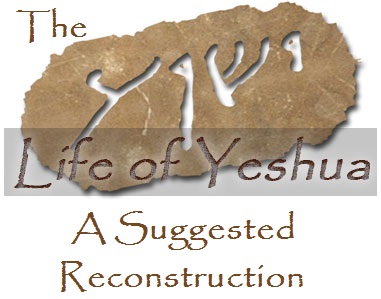Matt. 7:28; 8:5a; Luke 7:1
(Huck 44, 46, 79; Aland 76, 85; Crook 59, 89)[52]
וַיְהִי כְּכַלֹּתוֹ לְדַבֵּר אֶת כָּל הַדְּבָרִים הָאֵלֶּה בְּאָזְנֵיהֶם וַיִּכָּנֵס לִכְפַר נַחוּם
When Yeshua was finished telling them all these things he entered Kefar Nahum.[53]
Updated: 15 November 2024
| Table of Contents |
|
3. Conjectured Stages of Transmission 4. Comment 6. Conclusion |
 .
.
.
Reconstruction
To view the reconstructed text of Sermon’s End click on the link below:
Premium Members and Friends of JP must be signed in to view this content.
If you are not a Premium Member or Friend, please consider registering. Prices start at $5/month if paid annually, with other options for monthly and quarterly and more: Sign Up For Premium
Conclusion
Careful observation of Sermon’s End affords a glimpse at the way in which the author of Matthew juggled his sources and constructed his discourses. It also reveals the author of Matthew’s polemical agenda. Despite clear affinities between Jesus’ teachings in the Sermon on the Mount and the teachings of the rabbinic sages, the author of Matthew erected a rhetorical wall between Jesus and Judaism. The anti-Jewish trajectory of Matthew’s Gospel has contributed to fundamental misunderstandings of Jesus’ message and served to justify Christian anti-Semitism. It is our hope that our endeavor to reconstruct the sources behind the Synoptic Gospels will help to rectify some of the damage caused by the Church’s anti-Jewish legacy.
 Click here to return to The Life of Yeshua: A Suggested Reconstruction main page.
_______________________________________________________
Click here to return to The Life of Yeshua: A Suggested Reconstruction main page.
_______________________________________________________

- [1] See Young, JHJP, 252. ↩
- [2] See John C. Hawkins, “Probabilities As to the So-Called Double Tradition of St. Matthew and St. Luke,” in Studies in the Synoptic Problem (ed. William Sanday; Oxford: Clarendon, 1911), 95-138, esp. 121. Cf. Hawkins, 165; Nolland, Luke, 1:315; idem, Matt., 345. ↩
- [3] Cf. Harnack, 74; McNeile, 99; Streeter, 262; Schweizer, 192; Gundry, Matt., 136; Davies-Allison, 1:724 (with some hesitation); Nolland, Luke, 1:315; Luz, 1:389. ↩
- [4] Cf. Harnack, 74; Bultmann, 334 n. 1; Bundy, 196-197 §107; Beare, Earliest, 98; Marshall, 279; Davies-Allison, 1:724, 2:17; Catchpole, 284. See also Burnett Hillman Streeter, “On the Original Order of Q,” in Studies in the Synoptic Problem (ed. William Sanday; Oxford: Clarendon, 1911), 140-164, esp. 148. ↩
- [5] See J. Vernon Bartlett, “The Sources of St. Luke’s Gospel,” in Studies in the Synoptic Problem (ed. William Sanday; Oxford: Clarendon, 1911), 315-363, esp. 328. ↩
- [6] Cf. Catchpole, 281. ↩
- [7] For a precise measurement of the verbal agreement between the Lukan and Matthean versions of Sermon’s End, see LOY Excursus: Criteria for Distinguishing Type 1 from Type 2 Double Tradition Pericopae. ↩
- [8] Apart from the conclusions to his five major discourses, καὶ ἐγένετο + temporal marker + finite verb does not appear elsewhere in Matthew. However, Matt. 9:10 does contain one additional example of καὶ ἐγένετο, but this example is followed by genitive absolute + participle, a Greek construction. ↩
- [9] Cf. Plummer, Luke, 194; Fitzmyer, 1:650. ↩
- [10] Pace Harnack (74) and Gundry (Matt., 136), who regarded ἐπειδή in Luke 7:1 as “a Lukanism,” and Luz (1:389), who characterized Luke 7:1a as “completely Lukan.” ↩
- [11] Allen (73) rejected the notion that a connection between the Sermon on the Mount/Plain and Centurion’s Slave already existed at the pre-synoptic stage of the transmission because he could not explain the verbal and other disagreements between the Lukan and Matthean versions of Jesus’ homily on the Torah. Lindsey’s hypothesis accounts for the disagreements by positing the use by the authors of Matthew and Luke of two distinct but related sources, Anth. (Matthew) and FR (Luke). But even apart from Lindsey’s hypothesis, the differences between the Lukan and Matthean versions of the Sermon on the Mount/Plain can be explained on the basis of Lukan and/or Matthean redaction. ↩
- [12] Buth has shown that καὶ ἐγένετο + temporal marker + finite verb is indicative of a Hebrew—not an Aramaic—vorlage representing the literary Hebrew narrative structure impersonal וַיְהִי + setting + finite verb. See Randall Buth, “Distinguishing Hebrew from Aramaic in Semitized Greek Texts, with an Application for the Gospels and Pseudepigrapha” (JS2, 247-319, esp. 263-276); Randall Buth and Brian Kvasnica, “Critical Notes on the VTS” (JS1, 259-317, esp. 268-273 [Critical Note 5]). ↩
- [13] Luz, 1:389 n. 6. ↩
- [14] Cf. Catchpole, 285. Gundry (Matt., 136) supposed the author of Matthew drew καὶ ἐγένετο from a pre-synoptic version of the Houses on Rock and Sand parable, since καὶ ἐγένετο occurs in Luke’s parallel to Matt. 7:27 (∥ Luke 6:49). However, the occurrence of καὶ ἐγένετο in Luke 6:49 does not explain the Hebraic καὶ ἐγένετο + temporal marker + finite verb construction in Matt. 7:28, since the statement καὶ ἐγένετο τὸ ῥῆγμα τῆς οἰκίας ἐκείνης μέγα (“and the ruin of that house was big”) in Luke 6:49 lacks both a temporal marker and a finite verb. ↩
- [15] See McNeile, 99; Manson, Sayings, 178; Beare, Matt., 200. ↩
- [16] Cf. Randall Buth, “Evaluating Luke’s Unnatural Greek: A Look at His Connectives,” in Discourse Studies and Biblical Interpretation: A Festschrift in Honor of Stephen H. Levinsohn (ed. Steven E. Runge; Bellingham, Wash.: Logos Bible Software, 2011), 335-369, esp. 363. ↩
- [17] Cf. Streeter, 262; Luz, 1:389. ↩
- [18] Cf. Luz, 1:389 n. 6. ↩
- [19] Cf. Catchpole, 285. ↩
- [20] See Gundry, Matt., 136; Luz, 1:389 n. 6. ↩
- [21] See Bovon, 1:260 n. 13. ↩
- [22] Cf. Catchpole, 285. ↩
- [23] In LXX καὶ ἐγένετο ὅτε occurs as the translation of וַיְהִי כִּי in Judg. 1:28; 16:16, 25; 2 Kgdms. 7:1; 19:26. ↩
- [24] In LXX καὶ ἐγένετο ὅτε occurs as the translation of -וַיְהִי כְּ + infinitive construct in 3 Kgdms. 21:12 and Jer. 48[41]:13. Similarly, in Jer. 44[37]:11 καὶ ἐγένετο ὅτε occurs as the translation of -וַיְהִי בְּ + infinitive construct, and in Jer. 42[35]:11 καὶ ἐγενήθη ὅτε translates -וַיְהִי בְּ + infinitive construct. ↩
- [25] See Hatch-Redpath, 2:1319-1320; Dos Santos, 91. ↩
- [26] In Completion (L18) we reconstructed τελεῖν with גָּמַר (gāmar, “finish”), but there the context was direct speech, which we prefer to reconstruct in Mishnaic-style Hebrew. ↩
- [27] Catchpole (285), on the other hand, included ὁ Ἰησοῦς in his reconstruction of the pre-synoptic source for Sermon’s End. ↩
- [28] Catchpole (285) omitted πᾶς from his reconstruction of the pre-synoptic source for Sermon’s End. ↩
- [29] See LOY Excursus: Greek-Hebrew Equivalents in the LOY Reconstructions, under the entry for דָּבָר. ↩
- [30] Cf. Harnack, 74. ↩
- [31] Cf. Catchpole, 285. ↩
- [32] See A. B. Bruce, 136; Hawkins, 172-173; Creed, 70; Manson, Sayings, 178; Bundy, 77 §12; Beare, Earliest, 48 §12; idem, Matt., 200; Schweizer, 192-193; Gundry, Matt., 136; Strecker, 172; Davies-Allison, 1:725; Luz, 1:389; Nolland, Matt., 345. See also David Flusser, “The Synagogue and the Church in the Synoptic Gospels” (JS1, 17-40, esp. 23 n. 20). For doubts, see Fitzmyer, 1:542. ↩
- [33] See Schweizer, 192-193; Luz, 1:389. ↩
- [34] See Davies-Allison, 1:726. ↩
- [35] The addition of αὐτῶν to οἱ γραμματεῖς shows intentional dissociation from the Jewish scribes on the part of the author of Matthew. Cf. Kilpatrick, 111; Schweizer, 192-193; Strecker, 172; Luz, 1:390. Gundry (Matt., 137), citing Matt. 8:19; 13:52; 23:34, suggested that the author of Matthew added αὐτῶν in order to distinguish between the “bad” Jewish scribes and the “good” Christian scribes. Cf. Davies-Allison, 1:727. ↩
- [36] See Houses on Rock and Sand, under the “Story Placement” subheading. ↩
- [37] David Flusser, Die rabbinischen Gleichnisse und der Gleichniserzähler Jesus (Bern: Peter Lang, 1981), 213 (translation ours). ↩
- [38] Flusser, Jesus, 249. Cf. idem, “The Synagogue and the Church in the Synoptic Gospels,” 23, 36. ↩
- [39] We found λαός to be the product of Lukan redaction in Yohanan the Immerser’s Eschatological Discourse, L1 (Luke 3:15), and Yohanan the Immerser’s Execution, L2 (Luke 3:18). ↩
- [40] The Hebrew idiom דִּבֵּר בְּאָזְנֵי (dibēr be’oznē, “speak in the ears of”) occurs in Gen. 20:8; 23:13, 16; 44:18; 50:4; Exod. 11:2; Num. 14:28; 31:28, 30; 32:44; Josh. 20:4; Judg. 9:2, 3; 1 Sam. 8:21; 11:4; 18:23; 25:24; 2 Sam. 3:19 (2xx); 2 Kgs. 18:26; Isa. 36:11; Jer. 26:15; Prov. 23:9. Cf. Deut. 5:1; Jer. 28:7. We also find variations of the idiom such as “answer in the ears of” (Gen. 23:10), “read in the ears of” (Exod. 24:7; Deut. 31:11; 2 Kgs. 23:2; Jer. 29:29; 36:6 [2xx], 10, 13, 14, 15 [2xx], 21; Neh. 13:1; 2 Chr. 34:30), “complain in the ears of” (Num. 11:1) and “weep in the ears of” (Num. 11:18). ↩
- [41] Pace Bovon, 1:260 n. 13. ↩
- [42] Nevertheless, it is true that the only other instance of εἰς τὰς ἀκοάς in NT occurs in the story of Paul’s address to the Areopagus (Acts 17:20). There, however, εἰς τὰς ἀκοάς is not part of the Hebrew idiom of speaking words into someone’s ears. ↩
- [43] Catchpole (285) omitted εἰς τὰς ἀκοὰς τοῦ λαοῦ from his reconstruction of the pre-synoptic source for Sermon’s End. ↩
- [44] See Marshall, 279; Davies-Allison, 2:17; Luz, 2:8. ↩
- [45] Cf. Harnack, 74; Gundry, Matt., 141; Davies-Allison, 2:18. On the author of Matthew’s redactional use of the genitive absolute, see LOY Excursus: The Genitive Absolute in the Synoptic Gospels, under the subheading “The Genitive Absolute in Matthew.” ↩
- [46] Catchpole (285) adopted εἰσῆλθεν but not καί in his reconstruction of the pre-synoptic source for Sermon’s End. ↩
- [47] On the Second Temple-period source embedded in b. Kid. 66a, see Introduction to “The Life of Yeshua: A Suggested Reconstruction” Addendum: Linguistic Features of the Baraita in b. Kid. 66a. ↩
- [48] Cf. Catchpole, 285. ↩
- [49]
Sermon’s End
Luke’s Version
Anthology’s Wording (Reconstructed)
ἐπειδὴ ἐπλήρωσεν πάντα τὰ ῥήματα αὐτοῦ εἰς τὰς ἀκοὰς τοῦ λαοῦ εἰσῆλθεν εἰς Καφαρναούμ
καὶ ἐγένετο ὅτε ἐτέλεσεν πάντας τοὺς λόγους τούτους εἰς τὰς ἀκοὰς αὐτῶν καὶ εἰσῆλθεν εἰς Καφαρναούμ
Total Words:
14
Total Words:
16
Total Words Identical to Anth.:
6
Total Words Taken Over in Luke:
6
Percentage Identical to Anth.:
42.86%
Percentage of Anth. Represented in Luke:
37.50%
↩
- [50]
Sermon’s End
Matthew’s Version
Anthology’s Wording (Reconstructed)
καὶ ἐγένετο ὅτε ἐτέλεσεν ὁ Ἰησοῦς τοὺς λόγους τούτους ἐξεπλήσσοντο οἱ ὄχλοι ἐπὶ τῇ διδαχῇ αὐτοῦ.... εἰσελθόντος δὲ αὐτοῦ εἰς Καφαρναοὺμ....
καὶ ἐγένετο ὅτε ἐτέλεσεν πάντας τοὺς λόγους τούτους εἰς τὰς ἀκοὰς αὐτῶν καὶ εἰσῆλθεν εἰς Καφαρναούμ
Total Words:
21
Total Words:
16
Total Words Identical to Anth.:
9
Total Words Taken Over in Matt.:
9
Percentage Identical to Anth.:
42.86%
Percentage of Anth. Represented in Matt.:
56.25%
↩
- [51] Cf. Luz, 1:389. ↩
- [52] For abbreviations and bibliographical references, see “Introduction to ‘The Life of Yeshua: A Suggested Reconstruction.’” ↩
- [53] This translation is a dynamic rendition of our reconstruction of the conjectured Hebrew source that stands behind the Greek of the Synoptic Gospels. It is not a translation of the Greek text of a canonical source. ↩




